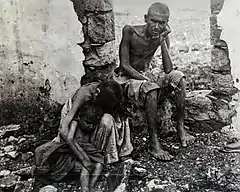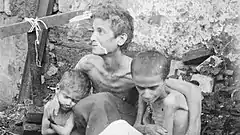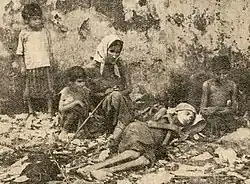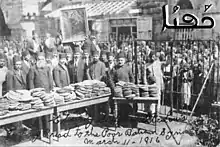Great Famine of Mount Lebanon
The Great Famine of Mount Lebanon (1915–1918) (Classical Syriac: ܟܦܢܐ, romanized: Kafno, lit. 'Starvation'; Arabic: مجاعة لبنان, romanized: Majā'at Lubnān; Turkish: Lübnan Dağı'nın Büyük Kıtlığı) was a period of mass starvation on Mount Lebanon during World War I that resulted in the deaths of 200,000 people, most of whom were Christians.[1]
| Great Famine of Mount Lebanon مجاعة لبنان | |
|---|---|
 Starving man and children in Mount Lebanon | |
| Country | Mount Lebanon Mutasarrifate, Ottoman Empire, modern day Lebanon |
| Location | Mount Lebanon |
| Period | 1915–1918 |
| Total deaths | Est. 200,000 |
| Effect on demographics | Population of 400,000 declined by 50% |
There were many reasons for the famine in Mount Lebanon. Natural as well as man-made factors both played a role. Allied forces blockaded the Eastern Mediterranean, as they had done with the German Empire and Austro-Hungarian Empire in Europe, in order to strangle the economy and weaken the Ottoman war effort.[2][3][4] The situation was exacerbated by Jamal Pasha, commander of the Fourth Army of the Ottoman Empire, who deliberately barred crops from neighbouring Syria from entering Mount Lebanon, in response to the Allied blockade.[5][6] Additionally, a swarm of locusts devoured the remaining crops,[7][5] creating a famine that led to the deaths of half of the population of the Mount Lebanon Mutasarrifate, a semi-autonomous subdivision of the Ottoman Empire and the precursor of modern-day Lebanon. Ottoman Mount Lebanon had the highest per capita fatality rate of any ‘bounded’ territory during the First World War.[8]
Other areas in modern-day Lebanon, according to multiple sources, were also famine-stricken. However, due to poor documentation, casualties were never recorded. Some of the areas hit with no documentation include Tyre, Zahle, Akkar and Bint Jbeil.
Background

Mount Lebanon was home to a diverse demographic of ethnicities, many of whom had fled from religious persecution elsewhere, such as the Christian Maronite population. It was documented that of the region’s population of 217,000 at the turn of the nineteenth century, the majority were Maronites, followed closely by the Greek Orthodox, Druze, Shi’ite Muslims and Sunni Muslims, with a small minority of Jews.[9]
European interest in the region and the segregation of religious communities as mandated by the Ottoman millet system lead to tensions between the different sects. This was worsened by the Ottoman Tanzimat reforms established in 1839 which made Christians equal to Muslims under the law. Previously, any non-Muslims living in the region had to pay a poll tax.[10] This tension culminated in the ‘Massacres of 1860’ or ‘Mad habibin al-Sittin’ where conflict between the Druze and Maronite inhabitants erupted from April until July. It is estimated that roughly 10,000 -15,000 Christians were killed however there is no substantial estimate of Druze casualties.[10]
The aforementioned intervention by European powers and the outbreak of violence resulted in the formation of the Mutasarrifate of Mount Lebanon as part of the ongoing Tanzimat reforms.[11] The Mutasarrifate was one of three entities in Greater Syria or ‘Bilad al-Asham’ under Ottoman control, including the Syrian[12] and Beirut Vilayets.[13] Mount Lebanon's economy relied heavily on sericulture; raw silk was processed in looms and finished goods were shipped to the European market.[7] While sericulture constituted 32.9% of Mount Lebanon’s income in 1914, 45.6% of the region’s economy was dependent on remittances from the diaspora in the Americas, making them the ‘largest’ source of income by the onset of the war.[8]
Causes
Famine is not characterised by a dearth of food but rather by the inability of people to access it.[14] Multiple factors compounded to create an environment that worsened the pre-existing food shortages caused by the First World War. In 'Famine Systems, Paul How highlights how famine is understood as an ‘out of control’ dynamic where five distinct conditions must be met in order for an incident of food insecurity to reach famine status.[15] These conditions include pressure, hold, self-reinforcing dynamics, the onset of a famine system and the re-balancing that collapses after it.[15]
Pressure
Pressure within a community occurs when external factors weaken ongoing food shortages. The impact of WWI acted as the primary example of pressure in Mount Lebanon: the Ottoman war effort that prioritised food for soldiers on the front lines when the Empire neared collapse and the Entente naval blockade impacted the economy.[16]
The movement of Ottoman troops to the front following the 1915 Suez Canal campaign caused a 'bottleneck' in the transportation system of Greater Syria.[17] While there was ample grain and wheat in Damascus,[16] moving it to the mountainous region of Mount Lebanon when the price of hiring a railway carriage had tripled became almost impossible. The Ottoman requisition of transport animals further plagued any efforts at moving aid to the mountainous region.[16]
Hold
The ‘hold’ in a famine system applies when something keeps or ‘holds’ pressure in place for a prolonged period without release.[15] The region’s ability to export silk, a backbone of the economy, to European countries such as France was inhibited as a result of Ottoman military alliances and the subsequent Entente Blockade. The Ottoman alliance with the Central Powers caused the Entente Powers to block international trade routes in order to hinder Ottoman supply ; see Blockade of the Eastern Mediterranean during World War I. This made the transportation of remittances into the region increasingly difficult, and was worsened by the congestion of land-based transport. The region’s dependence on income from external sources reduced local purchasing power and drove the price of food up as it became more scarce.[16] Low rainfall and record-breaking locust infestations laid waste to the remaining crops,[7][5] which further exacerbated the situation and put increasing pressure on already limited food supplies.[16]
Growing crops was already a challenge in the mountainous region, and the inhabitants relied on food imports from the adjacent Bekaa Valley and Syria. To counter the Allied Blockade, the Ottomans adopted a severe policy of acquisition by which all food supplies were prioritised for the army.[7] Jamal Pasha, commander of the Fourth Army of the Ottoman Empire in Syria, barred crops from entering Mount Lebanon.[5]
Self-reinforcing Dynamics
The inability to access already-diminished food supplies was further exacerbated by a black market run by well-connected usurers.[18] The black market for grain arose as a representation of self-reinforcing dynamics, perpetuated by humans in response to the food crisis. Merchants often 'strategically withheld'[16] their grain and wheat supplies from the market for weeks at a time in order to raise the price and then flood the market. While the Beirut municipality implemented solutions to the illegal trade, they were ultimately unsuccessful.[16]
The politicisation of aid was another self-reinforcing dynamic. In urban areas such as Beirut, the American University (formerly known as the Syrian Protestant College or SPC) distributed aid to locals on conditions of religious and moral ‘worthiness’.[19] US aid was sent via boat, the USS Caesar or ‘Christmas ship’ to modern-day Lebanon in an agreed break of the Entente blockade. However, it was stopped at Jaffa port in modern-day Israel and the aid never reached Mount Lebanon, where it was to be transferred upon arrival at the port in Beirut.[20] Self-reinforcing dynamics went so far that cannibalism became a common phenomenon, particularly amongst parents who ate their children.[21]
The above mechanisms contributed to the worsening food insecurity and culminated in the outbreak of famine. How long a famine will last is dependent on how long the pressure, hold and self-reinforcing dynamics are kept in place.
Collapse and Re-balancing
Re-balancing occurs when one or more aspects of the system collapse which allows for the stabilisation of food supply, in turn ending the famine.[15]
The end of the famine in Mount Lebanon coincided most notably with the end of the First World War in 1918, the collapse of the Ottoman Empire and the subsequent arrival of French and British forces into the region. However, the situation did not 'normalise' until the following year.[22]
For this reason, the creation of Greater Lebanon or 'Le grand Lebanon'[23] under the administration of France was objectively paradoxical:
''In that sense, the transition between Ottoman and French rule in Lebanon hinged on the ability of the French Empire to enforce a blockade for the duration of the war, and then arrive to relieve the famine its navy had helped create, with ships laden with grain.''[4]
First grain shortages

The Ottoman Empire joined the Central Powers in World War I on 28 October 1914.[24] The Ottoman government had appropriated all of the empire's railway services for military use, which disrupted the procurement of crops to parts of the empire.[25] One of the first cities to be hit by the grain shortage was Beirut. On 13 November 1914, only 2 weeks after the Ottoman Empire joined the war, a group of citizens stormed the Beirut municipality to warn the municipal council of the severe shortage of wheat and flour in the city. The train freight cars that regularly transported grains from Aleppo had not arrived and the bakery shelves were empty. Angry mobs looted the bakeries of whatever little reserves of flour and grain they had left.[26] The municipal council dispatched a message to then Beirut Vali Bekir Sami Kunduh who requested grain provisions from the governor of Aleppo Vilayet and urged the Ottoman authorities to prioritize grain shipping to Beirut. Acquiring train freight cars to transport anything to the Beirut Vilayet was impossible without paying large bribes to military commanders and to the railroad authorities. Grain prices began to soar, which prompted the president of Beirut's municipal body, Ahmad Mukhtar Beyhum, to address the grain supply bottlenecks himself.
On 14 November 1914, Beyhum took off to Aleppo, where he negotiated with authorities, securing grain freight cars from the Ottoman Fourth Army. The wheat was paid for from the municipal treasury. Grain freights arrived to Beirut on 19 November 1914 to the relief of the masses;[25] however, the crisis was to worsen as both reports of the Ottoman officials and correspondence from the Syrian Protestant College indicated that food shortages were to become a daily occurrence past November.[27]
Impact

Malnutrition and starvation left the inhabitants vulnerable to the spread of disease at a time of societal upheaval.[16] Malaria, typhus and body lice became widespread amongst a population which grew increasingly susceptible to such illnesses. This was worsened by the movement of troops across the country, who were at greater risk of dying from disease than battle wounds.[28]
Around 200,000 people starved to death at a time when the population of Mount Lebanon was estimated to be 400,000 people.[7][29] The Mount Lebanon famine caused one of the highest fatality rates by population during World War I, alongside the Armenian Genocide, the Assyrian Genocide and the Greek Genocide.[5] Bodies were piled in the streets and people were reported to be eating street animals. Some people were said to have resorted to cannibalism.[5][7]
Soup kitchens were set up but had little effect in relieving the starving population.[7] The Lebanese community in Egypt funded the shipping of food supplies to the Lebanese mainland through Arwad. This assistance was delivered to the Maronite patriarchate who distributed it to the populace through its convents.[18]
The Syrian–Mount Lebanon Relief Committee was "formed in June of 1916 under the chairmanship of Najib Maalouf and the Assistant Chairmanship of Ameen Rihani"[30] in the United States.
Literary references
On 26 May 1916, Gibran Khalil Gibran wrote a letter to Mary Haskell that reads: "The famine in Mount Lebanon has been planned and instigated by the Turkish government. Already 80,000 have succumbed to starvation and thousands are dying every single day. The same process happened with the Christian Armenians and applied to the Christians in Mount Lebanon."[5] Gibran dedicated a poem named "Dead Are My People" to the fallen of the famine.[31]
Tawfiq Yusuf 'Awwad's landmark full-length novel Al-Raghif (The loaf) is set in the impoverished mountain village of Saqiyat al-Misk during World War I. In the novel, 'Awwad describes scenes from the great famine.[32]
There was a woman, lying on her back, covered with lice. An infant with huge eyes was hanging to her naked breast. One of the men pushed her with his foot and waited... Tom bit his fingers and stepped forward. The woman’s head was tipped back and her hair was sparse. From her bosom jutted out a scratched and battered breast that the infant kneaded with his tiny hands and squeezed with his lips, then gave up and cried.
— Tawfiq Yusuf 'Awwad, Al-Raghif (1939)
Memorials

The first memorial to memorialize the victims of the famine was erected in Beirut in 2018, marking the 100th year since the end of the famine. The site is called "The Great Famine Memorial", and is located in front of the Saint-Joseph University It was erected based on initiatives by Lebanese historian Christian Taoutel (curator of the memorial) and Lebanese writer Ramzi Toufic Salame.[33]
See also
References
- Taoutel, Christian; Wittouck, Pierre. Le peuple libanais dans la tourmente de la grande guerre 1914-1918 d'après les Pères Jésuites au Liban (in French). Presses de l'Université Saint-Joseph. ISBN 9953455449.
- Cummings, Lindsey Elizabeth (2015). Economic Warfare and the Evolution of the Allied Blockade of the Eastern Mediterranean: August 1914-April 1917 (Thesis). hdl:10822/760795. S2CID 130072266.
- Linda Schilcher Schatkowski, «The famine of 1915-1918 in greater Syria», in J. Spagnolo (dir.), Problems of the modern Middle East in historical perspective, Essays in honor of Albert Hourani, Ithaca Press, Reading, 1992, 229-258
- Pitts, Graham Auman. “Make Them Hated in All of the Arab Countries: France, Famine, and the Creation of Lebanon.” Environmental Histories of World War I. Richard P. Tucker, Tait Keller, J.R. McNeill, and Martin Schmid, eds. Cambridge, U.K.: Cambridge University Press (2018)
- Ghazal, Rym (14 April 2015). "Lebanon's dark days of hunger: The Great Famine of 1915–18". The National. Retrieved 24 January 2016.
- Deringil, Selim (2019). The Ottoman Twilight in the Arab Lands: Turkish Memoirs and Testimonies of the Great War. Academic Studies Press. p. 31. ISBN 978-1-64469-090-1.
- BBC staff (26 November 2014). "Six unexpected WW1 battlegrounds". BBC News. BBC. BBC News Services. Retrieved 24 January 2016.
- "Was Capitalism the Crisis? Mount Lebanon's World War I Famine". Environment & Society Portal. 2021-01-23. Retrieved 2023-05-10.
- Ozavci, Ozan (2021). Dangerous Gifts: Imperialism, Security, and Civil Wars in the Levant, 1798-1864. Oxford University Press. pp. 229–244.
- Heraclides, Dialla, Alexis, Ada (2017). Humanitarian Intervention in the Long Nineteenth Century. Manchester University Press. pp. 134–143.
{{cite book}}: CS1 maint: multiple names: authors list (link) - "Mount Lebanon Mutasarrifate", Wikipedia, 2023-05-08, retrieved 2023-05-10
- "Syria vilayet", Wikipedia, 2023-02-19, retrieved 2023-05-10
- "Beirut vilayet", Wikipedia, 2023-04-11, retrieved 2023-05-10
- Sen, Amartya (1982). Poverty and Famines: An Essay on Entitlement and Deprivation. OUP Oxford. ISBN 978-0-19-828463-5.
- Howe, Paul (2018). "Famine systems: A new model for understanding the development of famines". World Development. Elsevier. 105: 144–155. doi:10.1016/j.worlddev.2017.12.028.
- Tanielian, Melanie (2012). The War of Famine: Everyday Life in Wartime Beirut and Mount Lebanon (1914-1918) (Thesis). UC Berkeley.
- Tanielian, Melanie (2012). The War of Famine: Everyday life in Wartime Beirut and Mount Lebanon (1914-1918). UC Berkeley. pp. 107–134.
- Tawk, Rania (18 April 2015). "Le centenaire de la Grande famine au Liban : pour ne jamais oublier (The Centenary of Lebanon's great famine: so that we don't forget)". L'Orient Le Jour (in French). Beirut: L'Orient – Le Jour. Retrieved 26 January 2016.
- Brand, Bilal, El Cheikh, Aaron Tylor, Orfali, Nadia (2016). "'That They May Have Life': Balancing Principles and Pragmatism in the Syrian Protestant College's Humanitarian Relief Projects during the Famine of World War I'". American University of Beirut: A Century and a Half: 51–62. doi:10.1080/19475020.2016.1162187. S2CID 156454518.
{{cite journal}}: CS1 maint: multiple names: authors list (link) - "Caesar Affair | International Encyclopedia of the First World War (WW1)". encyclopedia.1914-1918-online.net. Retrieved 2023-05-10.
- al-Qattan, Najwa (November 2014). "When Mothers Ate Their Children: Wartime Memory and the Language of Food in Syria and Lebanon". International Journal of Middle East Studies. 46 (4): 719–736. doi:10.1017/S0020743814001032. ISSN 0020-7438. S2CID 163058456.
- Bacha, François El (2021-11-10). "Lebanon / History: The Great Famine of Mount Lebanon during WW1". Libnanews, Le Média Citoyen du Liban. Retrieved 2023-08-07.
- Fieldhouse, D.K. (2008). "Lebanon and the French". academic.oup.com. Oxford Academic. Retrieved 2023-08-07.
- Herbert Albert Laurens Fisher (1936). A history of Europe: The liberal experiment. University of Michigan. p. 1161. Retrieved 15 March 2016.
- Tanielian 2014, p.738
- Tanielian 2014, p.737
- Tanielian 2014, p.741
- Zürcher, Erik Jan (1998). "The Ottoman Conscription System, 1844-1914". International Review of Social History. 43 (3): 437–449. doi:10.1017/S0020859098000248. ISSN 0020-8590. JSTOR 44583417. S2CID 145478019.
- Harris 2012, p.174
- Mujais, Salim (2004). Antoun Saadeh: The youth years. p. 107. ISBN 9789953417950.
- Gibran, Khalil Gibran (5 September 2013). "Dead Are My People". Poem hunter. Retrieved 24 January 2016.
- Allen, Roger; Allen, Roger M. A.; Lowry, Joseph Edmund; Stewart, Devin J. (2009). Essays in Arabic Literary Biography: 1850-1950. Otto Harrassowitz Verlag. ISBN 9783447061414.
- "Victims of the Great Famine of Mount Lebanon finally have a memorial monument in Beirut". The961. Lebanon: The961.com. 22 July 2018. Archived from the original on 25 December 2019. Retrieved 22 July 2018.
Bibliography
- Linda Schilcher Schatkowski, «The famine of 1915-1918 in greater Syria», in J. Spagnolo (dir.), Problems of the modern Middle East in historical perspective, Essays in honor of Albert Hourani, Ithaca Press, Reading, 1992, 229–258.
- Pitts, Graham Auman. “Make Them Hated in All of the Arab Countries: France, Famine, and the Creation of Lebanon.” Environmental Histories of World War I. Richard P. Tucker, Tait Keller, J.R. McNeill, and Martin Schmid, eds. Cambridge, U.K.: Cambridge University Press (2018)
- Pitts, Graham Auman (2020-09-22). "A Hungry Population Stops Thinking About Resistance: Class, Famine, and Lebanon's World War I Legacy". Journal of the Ottoman and Turkish Studies Association. 7 (2): 217–237. doi:10.2979/jottturstuass.7.2.13. S2CID 235051188. Retrieved 2022-09-14.
- al-Qattan, Najwa (November 2014). "When mothers ate their children: Wartime memory and the language of food in Syria and Lebanon". International Journal of Middle East Studies. 46 (4): 719–736. doi:10.1017/S0020743814001032. JSTOR 43303223. S2CID 163058456.
- Yann Bouyrat, « Une crise alimentaire « provoquée » ? La famine au Liban (1915-1918) », Actes des congrès nationaux des sociétés historiques et scientifiques, vol. 138, no 8, 2016, p. 22–37 https://www.persee.fr/doc/acths_1764-7355_2016_act_138_8_2870
- Harris, William (2012). Lebanon: A History, 600–2011. Oxford University Press. pp. 173–179. ISBN 9780195181111.
- Tanielian, Melanie Schulze (November 2014). "Feeding the city: the Beirut municipality and the politics of food during World War I". International Journal of Middle East Studies. 46 (4): 737–758. doi:10.1017/S0020743814001044. JSTOR 43303224. S2CID 153353905.
- Tanielian, Melanie Schulze (2018). Charity of War: Famine, Humanitarian Aid and World War I in the Middle East. Stanford University Press. ISBN 9781503603523.
- Taoutel, Christian; Wittouck, Pierre (2015). Le peuple libanais dans la tourmente de la grande guerre 1914-1918 d'après les Pères Jésuites au Liban (in French). Presses de l'Université Saint-Joseph. ISBN 978-9953455440.
- "Victims of the Great Famine of Mount Lebanon finally have a memorial monument in Beirut". The961. Lebanon: The961.com. 22 July 2018. Archived from the original on 25 December 2019. Retrieved 22 July 2018.
External links
- Tylor Brand: Caesar Affair, in: 1914-1918-online. International Encyclopedia of the First World War.